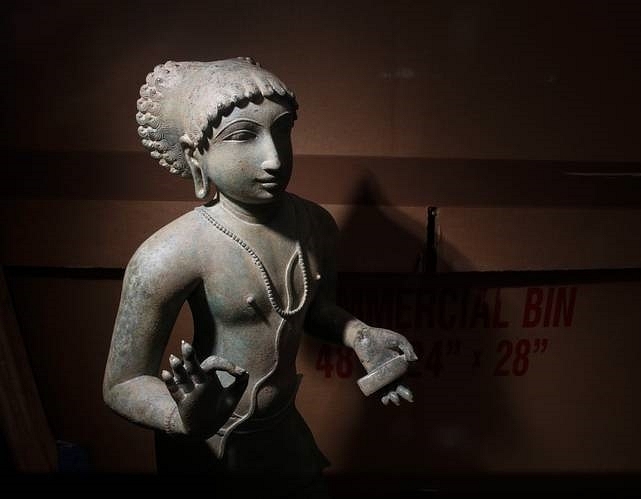World
The American Who Rescued The Saint
- Homeland Security’s special agent Brenton Easter has been instrumental in tracing stolen idols
- Red tape of Indian bureaucracy and the ill equipped custodians have sent him on wild goose chases

Getty Images
The historic return by America of over 200 cultural objects to Prime Minister Narendra Modi in Washington DC is matter of pride for India. These were smuggled out of India by notorious art thief Subhash Kapoor.
The Indian Minister of Commerce, in his own submission to Parliament, India brought back 18 Artefacts from Independence to 2015 (the actual number should be 21 – thanks to some glaring omissions by Archaeological Survey of India). Of this 21 – seven were the efforts of the India Pride Project. But this event in America changes the game – for they will be returning not one or two but 200.
So what has changed?
A non-descript city block in New York City holds the office of a key player in not just India’s battle against looting of its cultural treasures but the very epicentre of the Global struggle and America’s spear head to clamp down on the growing trade in illicit antiquities.
The quaint 5 by 5 office space is crammed with Indiana Jones memorabilia, paper clippings of art heists with fancy code names – “Mummy’s Curse” and “Hidden idol” . The overflowing dealer catalogues and books on art bear mute witness to the efforts of this hero – special agent Brenton Easter. (Also see this report)
Hair tucked under his signature baseball, bearing the initials B; the pursuits of this one man army has all the bearings of a Hollywood thriller, with a flood of raids, seizures and restitutions spanning the globe from Italy, Cambodia and now India. His only lament was “Get me a good counterpart in India – I just need someone willing to go the distance”.
For too long the red tape of Indian Bureaucracy and the ill equipped custodians have sent him on wild goose chases – including multiple weeks in hot and sultry India, with promises of arrests of the bad guys. Frustrating, when he has done all the hard work and with irrefutable proof of the bad guys shipping documents, email exchanges and bank transfers to see the patchy attempts in delaying and letting the actual crooks off the hook.
Lax policing at source countries combined by friendly legal framework has ensured time and again the kingpins of this global smuggling racket go unpunished.But the few restitutions do help to bring the spotlight back on the crux of the problem. Optical due diligence by the ultimate buyers – in this case the reputed Toledo Museum of Art in Ohio and a reputed private collector in New York.
The red tape buoying down the private efforts of Brenton and India Pride project came to the forefront in the case of Toledo Ganesha – the investigative work of Vijay coupled with Jason Felch helped to uncover the loot in the first place. Indian born techie Ravi Venugopal managed to get them high resolution photographs which were then matched to the source photographs from the French Institute in Pondicherry.
Though the Museum initially put up a stone wall, in private they wrote to the Indian Embassy and the Ambassador. Sadly, the letters went unanswered for months which finally led to them going to the media for help. The Toledo museum took not just the Ganesha off display but handed over hundreds of other items gifted and purchased from the now defunct dealership to Homeland Security.
The case of the Manikkavasagar was even more tricky. Just eight days after it was cleared by US customs in late March 2006, it was bought by a private collector for $650,000 and went off the radar. It was never exhibited or published till mid-2015, when increasing heat from US law enforcement led to the private collector “voluntarily” surrendering the bronze to Homeland Security.
The identity of the dealer has been protected since he could demonstrate that he purchased the bronze in “good faith” – which in Kapoor’s case, was a fake provenance paper from his estranged girlfriend’s art dealership in Singapore dated May 5, 2005. The letter claims the saint came “from a private collection” and “has been out of India for more than 30 years”.
Both the above bronzes were looted from the Sripuranthan temple as did the Nataraja (returned by the National gallery of Australia) and the Uma (returned by the Asian Civilisations Museum, Singapore). Many other bronzes taken by the same gang from the Sutamalli temple have been seized by Homeland Security in various Art of Past Warehouses and await procedural formalities to return. It is pertinent to mention here that the total number of bronzes stolen from just these two temples is 17 from Sutamalli and 8 from Sripurandan.
The recent (and much delayed ) raids on notorious art dealer in Chennai is a sure sign that the wheels have finally started to move in the right direction…but these restitutions are still a miniscule fraction of what is actually being looted and if India has to make a firm stance, it has to immediately:
1. Set up a strong and dedicated central Art Squad
2. Work on setting up a national archive
3. Show more action in going after the entire smuggling network basing on co-operation with international law enforcement agencies.
Introducing ElectionsHQ + 50 Ground Reports Project
The 2024 elections might seem easy to guess, but there are some important questions that shouldn't be missed.
Do freebies still sway voters? Do people prioritise infrastructure when voting? How will Punjab vote?
The answers to these questions provide great insights into where we, as a country, are headed in the years to come.
Swarajya is starting a project with an aim to do 50 solid ground stories and a smart commentary service on WhatsApp, a one-of-a-kind. We'd love your support during this election season.
Click below to contribute.
Latest